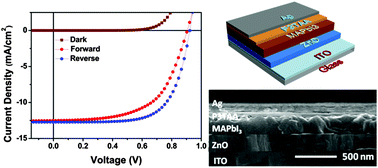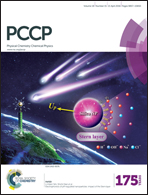Interface engineering of hybrid perovskite solar cells with poly(3-thiophene acetic acid) under ambient conditions†
Abstract
The properties of methyl ammonium lead iodide (MAPbI3) perovskite solar cells with poly(3-thiophene acetic acid) (P3TAA) as a hole transporting material (HTM) and a dense layer of ZnO nanoparticle film as an electron transporting material (ETM) are described using the conventional ZnO (n)/perovskite (i)/P3TAA (p) (n–i–p) architecture. The FT-IR spectra of a MAPbI3/P3TAA mixture indicate a shift of the N–H stretching and the abolition of the N–H bending peak indicating the interaction between the components. UV-Vis spectra of the mixture exhibit a large red shift of the π–π* transition peak of the conjugated chain arising from the interaction causing an increase of the conjugation length. The cross-sectional SEM image of the device shows the sequence of the individual layers of ZnO, MAPbI3, P3TAA and Ag, respectively. The current density (J)–voltage (V) curves obtained upon illumination with a light of 100 mW cm−2 indicate the average PCE to be 7.38 ± 0.59% under ambient conditions. The IPCE values of these cells reach about 63% across a broad range of wavelength (300–800 nm). The HOMO and the LUMO of P3TAA are measured using cyclic voltammetry and the optical band gap and the relative energy level of the components explain the operation of photocurrent in the cell. For comparison purposes a device using poly(3-hexyl thiophene) (P3HT) as the HTM is fabricated under similar conditions and it exhibits a lower PCE (5.85 ± 0.51%) than that of the P3TAA based device. The longevity of the P3TAA based cell is also found to be better than that of the P3HT based cell for storing in air. The UV-Vis and impedance spectral results clearly explain the above results, signifying the influence of the interface on the performance of hybrid solar cells.


 Please wait while we load your content...
Please wait while we load your content...